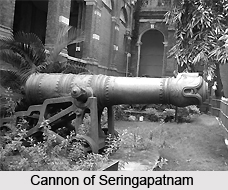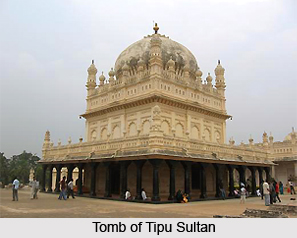 Primarily historical in character, the ancient monuments of Seringapatnam bear witness to the several important historic events. The city, however, gets its name from Sri Ranganatha Swamy temple which is situated here. Also known as Srirangapatnam, it is an island located in the Kaveri River about 75 miles from Bengaluru. Seringapatnem is best known for being the capital of two of the most famous Mysore Rajahs, Hyder Ali and Tipu Sultan.
Primarily historical in character, the ancient monuments of Seringapatnam bear witness to the several important historic events. The city, however, gets its name from Sri Ranganatha Swamy temple which is situated here. Also known as Srirangapatnam, it is an island located in the Kaveri River about 75 miles from Bengaluru. Seringapatnem is best known for being the capital of two of the most famous Mysore Rajahs, Hyder Ali and Tipu Sultan.
It has been the scene of a great many bloody struggles of the Indians against the British in the late 18th century. Tirumala Rayal, the last of the Vijayanagara viceroys, relinquished his power to the powerful Mysore ruler Raja Wadiyar in 1610. The Raja moved his capital to Seringapatam and Wadiyar and his three successors consolidated and extended the Mysore dominions. They were followed by a long succession of weak incapable rulers who were primarily working under the influence of their Diwans. An understanding of the historical background and of the British operations in and around Mysore makes a visit here much more rewarding.
 Historical Monuments in Seringapatnam
Historical Monuments in Seringapatnam
The main southern entrance to the island is the Mysore Gate. It was from this very site where 10,000 captives broke out of the city in 1792 seizing the opportunity afforded by Cornwallis` advance. To the north-east is the Flagstaff erected by Lord Wellesley on the great cavalier. Near here the colours of the 23rd Regiment were shot down during the assault and replaced by a red infantry jacket hoisted by a gallant group of British privates.
To the West is the Elephant Gate which was built in 1793.It was built in large enough proportions to be able to permit an elephant to pass. The grooved channels bear witness to the drawbridge which once protected the gate. A marble slab carries a fulsome Persian inscription.
Beyond the mandapa is the former garden of Captain Thomas Fiott de Havilland. The famous de Havilland Arch, which was built as an engineering department. It experimented in 1801 with a flat span of 34 m (112 ft).This fell in 1937 but the remnants can still be inspected. De Havilland was one of the most gifted military engineers of the period and he later used his experience of wide structural spans in the design of the Banqueting Hall at Government House, Mysore (1806-7) and at St Andrew`s Kirk, Chennai (1821).
The Delhi Gate led to the Delhi Bridge, which was dismantled by Tipu for defensive reasons, but the stone bases still remain in the riverbed. The northern rampart leads to the Sultan Battery and, beneath it, the dungeons, where many of the British prisoners were confined for years in appalling conditions. Standing up to their necks in water they were chained with arms crossed facing the wall and compelled to eat like horses, the food being placed on the stone ledges still to be seen inset in the walls.
 The Lal Mahal or Palace of Hyder Ali and Tipu Sultan was originally a fine building with an open balcony overlooking the Maidan.however, it has not been able to withstand the ravages of time and today only a tablet marks the spot where it once stood.
The Lal Mahal or Palace of Hyder Ali and Tipu Sultan was originally a fine building with an open balcony overlooking the Maidan.however, it has not been able to withstand the ravages of time and today only a tablet marks the spot where it once stood.
Gateway of the Fallen Fortress or Bidda Kote Bagalu had underground vaults which were also used as dungeons. The celebrated Maratha freebooter Dhondia Wahag was chained here for five years, before being released by British soldiers in 1799, after which he marauded around the territory committing depredations in every direction, until he was pursued and cut down by Wcllesley in 1800.
The Daria Daulat Bagh or Summer Palace of Tipu Sultan lies to the east. Now a Museum, it was built by Tipu in 1784 and is covered in rich arabesque detail over every inch of wall, ceilings and multifoil arches. The palace stands in a beautiful garden area stocked with plants and shrubs brought by Tipu from all over India. The west wall has a mural depicting the victory of Hyder Ali over Colonel Baillic at Pollilore in 1780. Restored by Wellesley, it was later whitewashed. Fifty years later it was crudely repainted by an Indian artist on the instruction of Lord Dalhousie.
 The Lalbagh or Garden of Rubies marks the site of a palace laid out by Hyder Ali. It was mud-brick two-storey palace adjacent to the Gumbaz mausoleum. Once alleged to be unparalleled in India, nothing now remains, although some of the timbers were salvaged and used in the building of St Stephen`s Church, Ootacamund. Others were later used in the restoration of Holy Trinity, Ootacamund, in 1930.
The Lalbagh or Garden of Rubies marks the site of a palace laid out by Hyder Ali. It was mud-brick two-storey palace adjacent to the Gumbaz mausoleum. Once alleged to be unparalleled in India, nothing now remains, although some of the timbers were salvaged and used in the building of St Stephen`s Church, Ootacamund. Others were later used in the restoration of Holy Trinity, Ootacamund, in 1930.
Right outside the entrance to the Lalbagh, is a memorial to Colonel William Baillie (1816) erected by his brother, Colonel John Baillie, the Resident at Lucknow. William Baillie was captured at Pollilore and died a prisoner of Tipu in 1782. The memorial is a domed octagonal pavilion, crowned by funeral urns, enclosed by whitewashed walls with a pillared porch. Adjacent is H M Cemetery, which contains many British graves.
3-2 km (2 miles) north of the road from Seringapatam to French Rocks is a simple granite column, the Rana Khaubha.It was erected by Purniah in memory of Josiah Webbe for his support to a claim of the Mysore revenues.
The Memorial Monument is a large obelisk raised to the memory of officers of the 77th (Highland Light Infantry) and 12th (Suffolk) Regiments who died during the final assault on 4 May 1799.
 The Memorial Mandapa was built to commemorate H H Krishna Raja Wadiyar III in 1915.It is an unassuming building on the site of the ancient palace of the Vijayanagara Viceroys.
The Memorial Mandapa was built to commemorate H H Krishna Raja Wadiyar III in 1915.It is an unassuming building on the site of the ancient palace of the Vijayanagara Viceroys.
Religious Monuments in Seringapatnam
The core of the Temple of Sri Ranganatha Swami, from which Seringapatnam gets its name, was built in 894. The temple was built by the Ganga dynasty rulers of the 9th century. It was later worked and improved upon some three centuries later. It is dedicated to Ranganatha, the reclining form of Lord Vishnu.
It is the scene of a great festival every January. Outside is a huge temple car which was restored in 1771. The Narasimha Swami Temple built in 1700, contains a fine portrait statuette of a heroic scion of the Wadiyar dynasty. Ganjam was established by Tipu as an industrial suburb. It is a village at the eastern end of the island of Seringapatam. As an outer suburb of the fortress it was dismantled by Tipu in 1799 in fear that the British army might occupy and make use of the area as they had done in 1792. It was re-built after the capture of Seringapatam. The main interest is the small, whitewashed Church of the celebrated Abbe Dubois of the Missions Etrangeres, who worked here from 1799 to 1823. The walls and ceiling of the transept remain as he built them. Dubois is known for having introduced vaccination to the state.
 The Jama Masjid (1787) lies close to the Ganjam or Bangalore Gate and was built by Tipu Sultan. It is a graceful affair with pierced minarets crowned by onion domes which contain narrow staircases. The mosque is cream-colored and within the embrasure of the gate is a small mound, the grave of Mir Muhammad Sadak, Hyder`s appalling diwan, master of the most dreadful tortures and later Tipu`s right-hand man.
The Jama Masjid (1787) lies close to the Ganjam or Bangalore Gate and was built by Tipu Sultan. It is a graceful affair with pierced minarets crowned by onion domes which contain narrow staircases. The mosque is cream-colored and within the embrasure of the gate is a small mound, the grave of Mir Muhammad Sadak, Hyder`s appalling diwan, master of the most dreadful tortures and later Tipu`s right-hand man.
The Gumbaz, built in 1784, was laid out by Tipu at great expense and planted with ornamental trees from Kabul and Persia. A musicians` gallery or Naubat Khana stands over the gateway.
Within the Gumbaz is the austere Mausoleum of Hyder Ali and Tipu Sultan (1799), a severe, square building crowned by a dome with corner minarets surrounded by a corridor carried on polished pillars of hornblende. It is approached via an avenue of tall sentinel cypresses. Around the main tomb are cloisters containing the remains of relatives and friends of the dynasty. The ebony and ivory doors were renewed at Lord Dalhousie`s expense in 1855.
The tomb of Hyder Ali is in the middle, that of his consort, Fakhr-un-Nissa Seydani Begum, on the east and of their son, Tipu Sultan, on the west. Their bodies lie in the crypt below. The tombs are usually covered with shawls: red for Tipu as `a martyr for the faith`, black or purple for Hyder and pink for Seydani Begum. Tipu was interred with full military honours by the British to peals of extraordinary, apocalyptic thunder, so severe that two officers who survived the assault unscathed were struck dead by lightning.
 The Tomb of Mir Ghulam Ali Khan commemorates one of Tipu`s most gifted statesmen, although the graves within are probably those of his mother and two wives. The mausoleum is a grand affair with a magnificent dome.
The Tomb of Mir Ghulam Ali Khan commemorates one of Tipu`s most gifted statesmen, although the graves within are probably those of his mother and two wives. The mausoleum is a grand affair with a magnificent dome.
At Garrison Cemetery, built in 1800, are a number of interesting graves to be seen, including those of Scott`s wife, officers of the Swiss Regiment de Meuron (which served the East India Company) and many others. The cemetery is an appropriate place to contemplate the history of the island.
Seringapatnam is thus full of historical significance. It is strewn with monuments that mark the life and chronicles of two of the greatest sons of the soil-Hyder Ali and Tipu Sultan.




